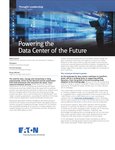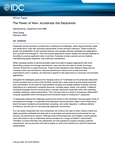Cloud migration is a complex process, and it’s no wonder that there are numerous myths and misconceptions surrounding it.
Many companies have already taken the leap into cloud-based solutions, but for those still considering their options, navigating the abundance of information about cloud migration, including misinformation, can be overwhelming. Even for those who’ve already begun their migration journey and are now looking to optimize their cloud environment, the process can be daunting.
So, let’s debunk the three most common myths about cloud migration and instead provide a step-by-step outline of what a successful migration strategy might look like.
1: A universal cloud migration solution
Unfortunately, there is no universal cloud migration solution that fits every company, regardless of its size, structure, operation, and industry. A one-size-fits-all approach will likely lead to an unnecessarily costly and inefficient operation, especially when you consider the limitations of certain cloud offerings.
Companies are different, and many factors, from budgets to existing infrastructure (such as on-premises servers and virtual machines) and application complexity, will significantly impact the optimal cloud model choice.
Despite being widely popular, the public cloud cannot be a one-stop shop for every business. Relying solely on the public cloud can lead to drawbacks such as limited control over the underlying infrastructure, performance issues for certain situations and operations as well as unforeseen costs. It also poses challenges in accommodating specific security needs around data and compliance, as the public cloud is exactly that: public.
In short, a range of challenges require a range of solutions. That means migrating to alternative models such as private, hybrid, and managed cloud solutions.
So, it is not a surprise that the hybrid approach, which combines the strengths of both private and public clouds, is a model that's currently experiencing active growth. A hybrid strategy lets companies take advantage of the control and security of the private model without losing the public cloud’s scalability and cost-effectiveness for non-critical workloads. In addition, a hybrid approach means you avoid getting deeply embedded into a lone vendor’s ecosystem, which can sometimes hinder you from choosing the market’s best tools and services for your needs.
In the end, it’s about choosing the solutions that best suit the company’s list of short and long-term needs. Start by defining your company’s needs and how they match up to each cloud solution’s strengths and weaknesses, and go from there.
2: Cloud migration must happen ASAP
Companies dread the idea of being stuck in limbo when planning cloud migration, and rightly so. But that doesn’t mean rushing the process is the solution.
Planning is key. Prioritizing speed during a cloud migration without the proper strategy and execution can easily lead to security vulnerabilities, compatibility challenges, and increased costs. Misconfigurations, for example, are security gaps that can be hard to spot and lead to data breaches. What’s more, compatibility issues between existing systems and the new cloud environment can be an expensive and time-consuming problem to fix.
A phased approach is a good way to avoid these problems. Not only is it a good way to break the process down into manageable chunks, it's also smoother and safer in the long run.
3: Security is the cloud provider’s responsibility
Security in the cloud is a shared responsibility, and cloud providers put significant investments towards securing their infrastructure. However, the responsibility of securing sensitive data belongs to the company migrating.
Companies need to be aware of this and actively manage and control their security during the move by implementing measures such as data encryption, access controls, and threat monitoring. Again, this should be planned beforehand and done in stages.
While there are more myths and misconceptions, knowing the truth behind these three is the foundation of a successful move.
Now, let’s explore some practical steps of cloud migration.
A Structured Approach
Taking a step back and evaluating your existing infrastructure, applications, and data is the first step in cloud migration. Once you know what you have, you can start defining your goals to inform the scope and direction of your migration. With an overview and goals in place, it’s time to decide on an approach. There are several options here, such as:
- Lift and shift: a “lift and shift” is the fastest and most straightforward approach since it essentially moves your existing application code to its new location without making many (or any) changes.
- Re-factoring: involves modifying the application code to suit the new environment.
- Re-platforming: this means rebuilding the application from scratch to suit its new destination. It’s the most resource-intensive and time-consuming option of the three, but it can also pay dividends for long-term efficiency.
The best approach will depend on the company’s needs and the complexity of its projects and applications. After creating a cloud migration strategy, do some research on cloud providers and managed cloud providers. Look into what services they offer, how much they cost, their security features, the benefits of unmanaged versus managed, and how well they match your specific needs, budget, and security requirements.
Once you've chosen a provider, it's time to move your data and applications to the cloud. To minimize disruptions and ensure a smooth transition, do this in stages with proper testing and rollback plans in place.
The final step in ensuring a smooth transition across the entire organization is to prepare your workforce. This involves educating executive leaders and other stakeholders about the process, potential challenges, and the expected benefits. This fosters buy-in from the top down. Additionally, equipping employees with training on new cloud-based tools and processes is essential for smooth adoption. Don't forget to offer ongoing support and resources to address any challenges and ensure employees feel comfortable and proficient in the new system.
It’s worth noting that few cloud migrations are final. While the bulk of the move may be complete, you'll need to monitor and fine-tune your cloud environment over time. This might involve tweaking how resources are distributed or exploring new cloud services that can improve your operations and keep costs in check.
Final thoughts
By debunking common myths and misconceptions, taking a structured approach, and focusing on key considerations, organizations can embark on a successful cloud migration journey. This paves the way for greater efficiency, flexibility and agility to scale and grow.
With Gartner predicting that the cloud will be a core part of business by 2028, this could be a wake-up call for organizations not yet in the cloud to start planning their migration now, in 2024.








